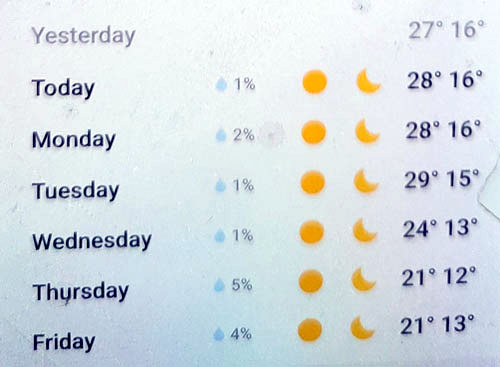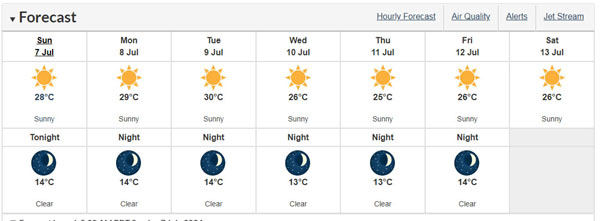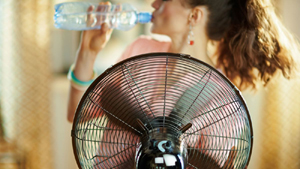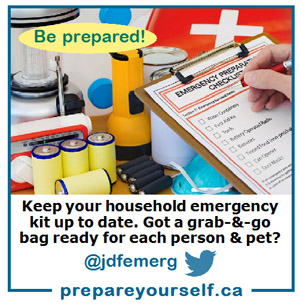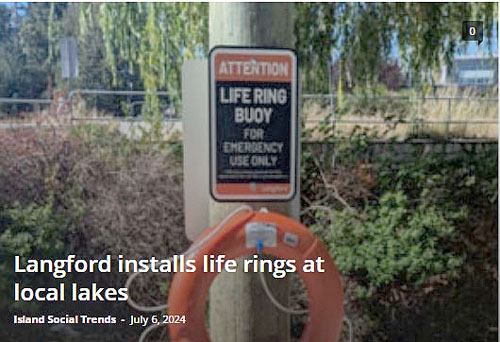Sunday July 7, 2024 | VICTORIA, BC
by Mary P Brooke, B.Sc. | Island Social Trends
The first heat wave of summer 2024 is upon us. High day-time temperatures as well as high night-time temperatures can be a health risk.
With elevated temperatures, the risk of heat-related illness increases, says Island Health. Staying hydrated is very important, as well as staying cool.
People over age 65 and very young persons including infants are susceptible to extreme heat.
Temperature thresholds:
The BC HARS regional temperature threshold for Southwest BC (which includes Vancouver Island) is a daytime high of 29 C followed by a nighttime low of 16 C.
Yesterday July 6 the high was 27°C in Victoria and Langford (with a low of 16°C). Today July 7 it is already 23°C at 9 am with an expected high of 26°C and a low of 16°C.
Heat forecast for the Victoria area:
According to weather.com the high for Victoria and Langford is forecasted to reach 27°C on Monday July 8 and 28°C on Tuesday July 9 (with lows of 16°C and 15°C respectively).
According to Environment Canada for Victoria, the weather forecast for today, Monday and Tuesday is hotter with highs of 28°C, 29°C and 30°C respectively (with cooler nights at 24°C).
Temperatures are expected to be more seasonal starting Wednesday July 10, with a high of 23°C in the forecast for Wednesday, then 21°C on Thursday and Friday.
Warnings have evolved since 2021 heat dome:
BC HARS and other government-driven heat warning processes have evolved since the heat dome experience of June 2021 during which over 600 people died from heat stress (mostly people indoors in spaces that were not air conditioned or cooled).
In 2021, the BC government did not heed the information and warnings from the meteorological (weather-forecasting) sector which had pre-advised about the pending heat dome that ran June 25 to 30 that year.
To be clear, this 2024 heat wave is *not* a heat dome, but the impacts of heat are still significant.
Tips to beat the heat:
Ahead of this weekend with steady hot temperatures in the forecast, Island Health issued information to assist people with heat management.
They have outlined the different types of heat alerts, how to prepare for hot temperatures, symptoms of heat-related illnesses, those most at risk during hot weather and ways to stay cool.
For more information, tips and resources, see Island Health Heat Safety webpage.
Preparing for and responding to hot weather
- If you have air conditioning at home, make sure it is in good working order.
- If you do not have air conditioning at home:
- Find somewhere you can cool off on hot days. Consider places in your community to spend time indoors such as libraries, community centres, movie theatres or malls. Also, as temperatures may be hotter inside than outside, consider outdoor spaces with lots of shade and running water.
- Close windows, curtains and blinds during the heat of the day to block the sun and prevent hotter outdoor air from coming inside. Open doors and windows when it is cooler outside to move that cooler air indoors.
- Ensure that you have a working fan, but do not rely on fans as your primary means of cooling. Fans can be used to draw cooler late-evening, overnight and early-morning air indoors.
- Keep track of temperatures in your home using a thermostat or thermometer. Sustained indoor temperatures over 31 C can be dangerous for people who are susceptible to heat.
- If your home gets very hot, consider staying with a friend or relative who has air conditioning if possible.
- Identify people who may be at high risk for heat-related illness. If possible, help them prepare for heat and plan to check in on them.
Who is most at risk?
It is important to monitor yourself, family members, neighbours and friends during hot weather. Consider developing a check-in system for those who are at high risk of heat-related illness.
Everyone is at risk of heat-related illness, but hot temperatures can be especially dangerous for:
- Older adults
- People who live alone
- People with mental illnesses such as schizophrenia, depression or anxiety
- People with pre-existing health conditions such as diabetes, heart disease or respiratory disease
- People with substance use disorders
- People with limited mobility and other disabilities
- People who are marginally housed
- People who work in hot environments
- People who are pregnant
- Infants and young children
Your health:
- Drink plenty of water and other liquids to stay hydrated, even if you are not thirsty.
- Spray your body with water, wear a damp shirt, take a cool shower or bath or sit with part of your body in water to cool down.
- Take it easy, especially during the hottest hours of the day.
- When outside, stay in the shade and use a broad-spectrum sunscreen with SPF 30 or higher.
Take immediate action to cool down if you are overheating. Signs of overheating include feeling unwell, headache and dizziness. Overheating can lead to heat exhaustion and heat stroke.
• Signs of heat exhaustion include heavy sweating, severe headache, muscle cramps, extreme thirst and dark urine. If you are experiencing these symptoms, you should seek a cooler environment, drink plenty of water, rest, use water to cool your body and monitor your symptoms.
• Signs of heat stroke include loss of consciousness, disorientation, confusion, severe nausea or vomiting and very dark urine or no urine. Heat stroke is a medical emergency.
In the event of a medical emergency, call 911. However, it is important to use 911 responsibly to avoid overwhelming the system.
When to call 911:
• In cases of heat stroke: loss of consciousness, disorientation, confusion, severe nausea or vomiting or very dark urine or no urine.
• In general: when there is chest pain, difficulty breathing, loss of consciousness, severe burns, choking, convulsions that are not stopping, a drowning, a severe allergic reaction, a head injury, signs of a stroke, signs of an overdose or a major trauma.
If you have a less urgent health issue:
• You can call HealthLinkBC at 811 and speak with a nurse or go to an urgent care centre or clinic if you can do so safely. That way, our emergency medical dispatch staff and paramedics will be available for people who need their services the most.
• There are also online tools at healthlinkbc.ca, including a “Check Your Symptoms” tool.
BC Heat Alert and Response System (BC HARS):
• The BC HARS includes two levels of alerts: heat warning and extreme heat emergency. The criteria for the BC HARS are as follows:
o Heat warning:
Two or more consecutive days in which daytime maximum temperatures are expected to reach or exceed regional temperature thresholds and night-time minimum temperatures are expected to be above regional temperature thresholds.
After the first three events of the summer in a given forecast region, the BC HEAT Coordinating Committee (BC HEAT) may recommend extending the minimum number of days for Heat Warning criteria in that region by a day
A moderate increase in public health risk.
o Extreme heat emergency:
Heat warning criteria have been met and daytime maximum temperatures are expected to substantively increase day over day for three or more consecutive days.
A very high increase in public health risk.
The BC HARS regional temperature threshold for Southwest B.C. is a daytime high of 29 C, nighttime low of 16 C.
For updates, please continue to check Environment and Climate Change Canada, and Island Health’s News webpage and social media accounts – @vanislandhealth for Facebook, X (formerly Twitter) and Instagram.
For more information, tips and resources, see Island Health Heat Safety webpage.
===== RELATED:
- It’s hot out there – know the signs of heat exhaustion (July 26, 2022)
- Meteorologist tells UBCM: heat dome was no surprise (September 15, 2021)
- NEWS SECTIONS: HEALTH


